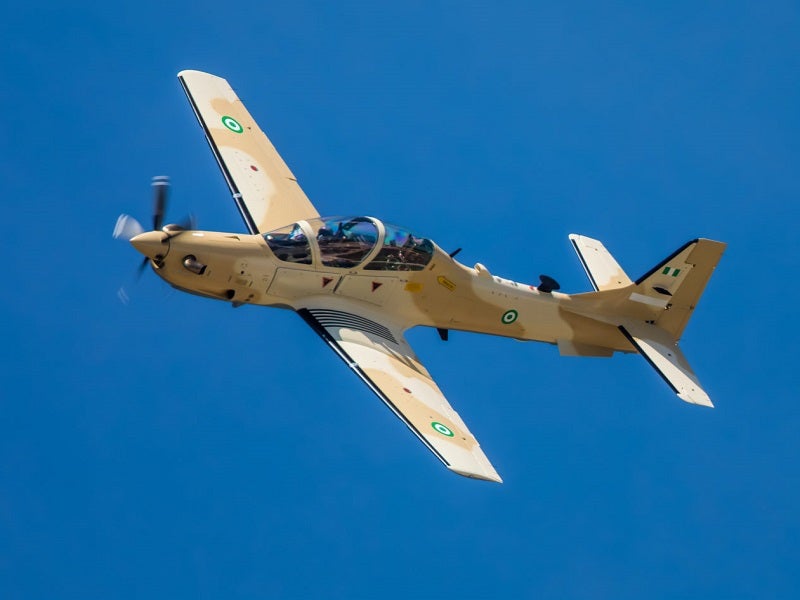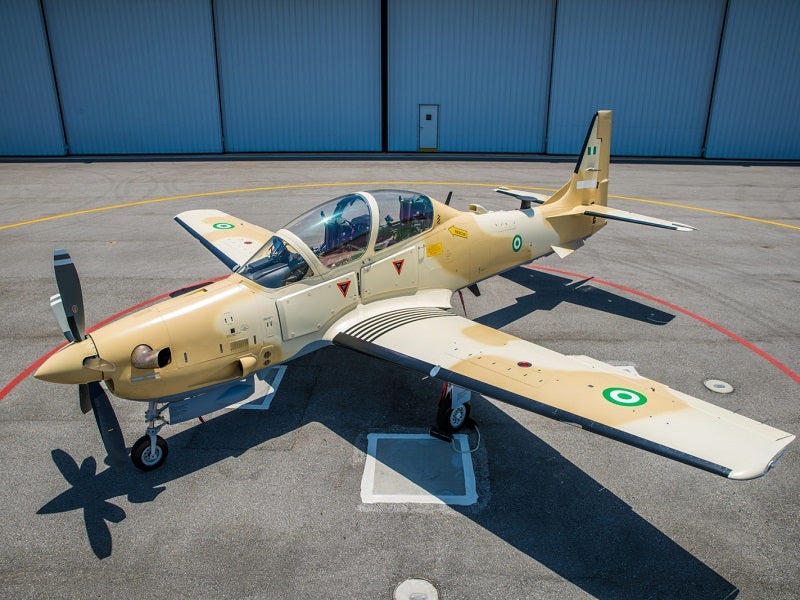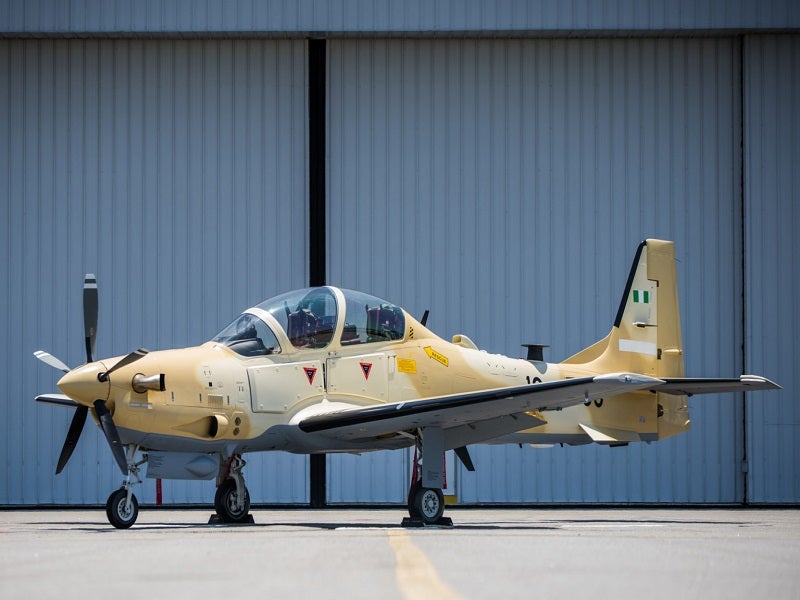EMB-314 Super Tucano is an enhanced version of the EMB-312 Tucano trainer aircraft that features faster speed and higher altitude capabilities.
The prototype of the Super Tucano first flew in 1992. Both Tucano and Super Tucano were developed by Embraer, a Brazilian aerospace and defence company.
Embraer manufactures the aircraft in Brazil and also partnered with Sierra Nevada Corporation (SNC) to produce the aircraft in the US for export customers.
In addition to basic and advanced pilot training, the main missions of the aircraft are border patrol and counter-insurgency operations.
Super Tucano ALX light attack aircraft development
Embraer was awarded a contract in 1995 to develop a variant of the Super Tucano, known as the ALX or light attack aircraft, for the Brazilian Air Force (FAB). One of the main missions of the aircraft is border patrol under the Sistema de Vigilancia da Amazonia (SIVAM) programme and so the ALX was optimised for the environmental conditions of the Brazilian Amazon. The first production aircraft was completed in 1999.
The Brazilian Air Force awarded Embraer a contract for 76 Super Tucano / ALX aircraft with options for a further 23 aircraft in August 2001. 51 of these aircraft are two-seater versions, designated AT-29, which replaced the AT-26 Xavante advanced jet trainers, while the remaining 25 aircraft are the single-seat A-29 ALX versions.
The first aircraft was delivered in December 2003. By September 2007, 50 aircraft entered service. The 99th and last A-29 aircraft was delivered in June 2012.
The A-29 Super Tucano has been selected by more than 15 air forces worldwide.
EMB-314 / A-29 Super Tucano design and features
The Super Tucano aircraft is a durable and versatile aircraft equipped with a powerful turboprop arrangement. It is claimed to be the only military type-certified aircraft in the light attack class. The aircraft ensures low operational and sustainment costs.
The ALX is capable of operating day and night missions from remote bases and unpaved runways with minimal ground support.
The flight envelope of the aircraft is 7g and -3.5g. Its small size, small visual and radar signatures, together with high speed and agility, give the aircraft high-survivability. Additional survivability features include armour protection and critical systems redundancy.
EMB-314 Super Tucano orders and deliveries
Embraer announced the signing of a contract with the Dominican Republic for ten Super Tucano aircraft for pilot training, internal security, border patrol and counter-narcotics trafficking missions in August 2001. The order was reduced to eight aircraft in January 2009. The first two Super Tucano aircraft were delivered to the Dominican Republic on 18 December 2009. Three were delivered in June 2010 and the remaining three in October 2010.
Venezuela selected the EMB-314 Super Tucano in February 2005. A total of 12 aircraft were to be ordered, with a further 12 planned. The sale fell through because it was thought the US would block the transfer of US-built components.
The Columbian Air Force placed a contract for 25 Super Tucano aircraft in December 2005. The first five were delivered in December 2006, with the final delivery completed in August 2008. The aircraft are used for border patrol and internal security. Elbit Systems was contracted to supply the avionics suite.
In April 2008, the Chilean Air Force selected the EMB-314 Super Tucano, with a requirement for 12 aircraft. A contract for the 12 aircraft was signed in August 2008. Embraer delivered first four of the 12 aircraft to the Chilean Air Force on 23 December 2009. The Dominican Republic placed a contract for eight Super Tucano aircraft in late 2008.
The Ecuadorian Air Force (EAF) ordered 24 Super Tucano aircraft in March 2009 as part of a $270m agreement signed with Embraer in 2008. A total of six Super Tucanos were delivered by April 2010. The EAF reduced its order from 24 to 18 in May 2010 to acquire 12 second-hand Cheetah C fighters from Denel Dynamics.
Embraer signed a contract with the Indonesian Ministry of Defence in November 2010 to supply eight A-29 Super Tucano light attack and advance trainer aircraft for superseding a fleet of OV-10 Broncos. It also included the supply of ground support stations and an integrated logistics package. The contract was finalised and became effective from 9 June 2011. The first four aircraft were delivered in August 2012.
The Indonesian Air Force placed an order for a second batch of eight A-29 Super Tucano aircraft and a flight simulator in July 2012.
The Philippine Air Force (PAF) awarded a contract to Embraer for six A-29 aircraft in November 2017. Deliveries to the PAF were completed in October 2020. The aircraft are in service with the 15th Strike Wing of the PAF.
Embraer and its partner SNC received a contract from the Nigerian Air Force (NAF) for the delivery of 12 A-29 Super Tucano light attack aircraft in December 2018.
The contract also includes ground training equipment, mission planning devices, mission debrief systems, ground support systems and additional mission equipment the NAF. The first A-29 completed its inaugural flight for the NAF at a production facility in Jacksonville, Florida, in April 2020. The first batch of six A-29 Super Tucanos was inducted into the NAF in August 2021, while the remaining six A-29s are expected to be delivered to the NAF by the end of 2021.
The Lebanese Air Force (LAF) took the delivery of four A-29 aircraft in June 2018, completing an order for six aircraft. The first two aircraft of the order were delivered to the LAF in October 2017. The acquisition contract also included logistics support, spares, and training.
USAF’s Light Air Support programme
A-29 Super Tucano was selected by the US Air Force (USAF) for its Light Air Support (LAS) programme in December 2011. Under the $355m contract, 20 aircraft were expected to be delivered in partnership with SNC, who was the prime contractor of the programme. The contract was cancelled in February 2012 due to concerns over the procurement process. The USAF placed a $427m order with Embraer to deliver 20 A-29 Super Tucano aircraft to the Afghan Air Force, in February 2013. The first aircraft was rolled out in September 2014.
The Afghan Air Force took delivery of the first four aircraft in January 2016, while the remaining aircraft delivered by the end of 2018.
A new contract for an additional six A-29s was placed in October 2017. The Afghan Air Force received 22 A-29s, as of September 2018. SNC was awarded a $1.808bn contract by US for procurement, modifications, ferry, sustainment, and related equipment for the A-29 in September 2018.
EMB-314 Super Tucano cockpit
The all-glass cockpit is fully compatible with night-vision goggles. Brazilian AF ALX aircraft are equipped with avionics systems from Elbit Systems of Haifa, Israel, including a head-up display (HUD), advanced mission computer, navigation system, and two 6in x 8in colour liquid crystal multi-function displays.
The head-up display with 24° field of view and the advanced weapon delivery system are integrated through a MIL-STD-1553B data bus. The pilot is provided with a hands-on throttle and stick (HOTAS) control.
The pilot is protected with Kevlar armour and provided with a zero/zero ejection seat. The clamshell canopy, hinged at the front and rear and electrically activated, is fitted with a de-icing system and features a windshield capable of withstanding, at 300k, the impact of a 4lb bird. A Northrop Grumman onboard oxygen generation system (OBOGS) is installed.
Weapons The aircraft is fitted with two central mission computers. The integrated weapon system includes software for weapon aiming, weapon management, mission planning and mission rehearsal. Onboard recording is used for post mission analysis.
There are five hardpoints for carrying weapons, and the aircraft is capable of holding a maximum external load of 1,500kg. The aircraft is armed with two wing-mounted 12.7mm machine guns with a rate of fire of 1,100 rounds a minute and is capable of carrying general-purpose bombs and guided air-to-air and air-to-ground missiles. Brazilian AF aircraft are armed with the MAA-1 Piranha short-range infrared guided air-to-air missile from Orbita.
The two-seat AT-29 is fitted with a forward-looking infrared AN/AAQ-22 SAFIRE turret on the underside of the fuselage. The SAFIRE thermal imaging system supplied by FLIR Systems is for targeting, navigation and target tracking. The system allows the aircraft to carry out night surveillance and attack missions. In July 2012, Embraer and Boeing signed a cooperation agreement to add new weapons integration capacity on the A-29 Super Tucano to satisfy the requirements of the US Air Force LAS programme.
Savis, Bradar and Rockwell Collins entered an agreement with Embraer to improve the defence applications of the aircraft in April 2017. The radar technology is integrated into the Rockwell Collins FireStorm™ system to improve fire precision of the aircraft.
Navigation
The aircraft is equipped with an advanced laser inertial navigation and attack system, a global positioning system (GPS) and a traffic alerting and collision avoidance system (TCAS).
EMB-314 Super Tucano propulsion details
EMB-314 Super Tucano is powered by a PT6A-68A turboprop engine, developing 969kW. The power plant is fitted with automatic engine monitoring and control. The ALX aircraft has a more powerful engine than the EMB-314.
The ALX’s Pratt and Whitney Canada PT6A-68/3 turboprop engine, rated at 1,600shp, drives a Hartzell five-bladed constant speed fully feathering reversible pitch propeller.
The fuel capacity is 695l, which gives a range of over 1,500km and endurance of 6hrs 30mins.
Performance of Super Tucano
EMB-314 can fly at the rate of 24m/s. The maximum and cruise speed of the aircraft are 530km/h and 593km/h respectively.
The range and service ceiling of the Super Tucano are 4,820km and 10,670m respectively. Its maximum endurance is six hours and 30 minutes. The aircraft weighs 3,020kg and has a maximum take-off weight of 5,200kg.






